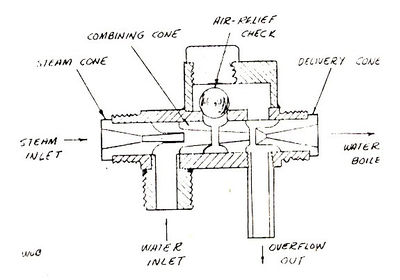Injectors - A Blessing or a Curse?
Injectors - A Blessing or a Curse?
It is hoped that after reading the following dissertation that many who own and operate injectors will find the first subtitle descriptive, and not the latter. There is not much question that for relatively low cost and ease of fitting up, the injector is a simple boiler feeding device. They can be removed easily and cleaned, or spares can be put in place in a a few minutes. They can be turned on when the boiler pressure gets high and then keep the safety valves quiet, and they can still feed when pressure is lower, by water valve adjustment.
However there are certain conditions that must be obtained in order to assure good operation and failure to meet these will cause problems. One of the biggest problems is in new boiler installations. it is almost impossible to get a new boiler clean from all kinds of junk that occurs during the manufacture unless it is steamed up and blown down a few times. The other common problem is in poor suction lines. A good injector will pull up to 15 inches of vacuum and this means good air-tight lines right up through tender strainers. Any air pulled in is fatal. Adequate size steam and water lines right up through valves are important. Steam and water lines should be kept as short as possible or go to the next size of tubing. Easy bends (no cast elbows or tees used) and unrestricted lines are essential. Steam- and water-tight check valves also make a big difference in operation. A hot injector will not pull water and condense steam to provide the velocity to overcome boiler pressure.
It is also very important to keep the injector clean. All water has various kinds of impurities that just delight in collecting in injector cones. The best thing is to remove the beggar after every run and blow out dry. Soak in white vinegar for a couple of hours and neutralize in clean water and blow out dry. A lot of injectors will lift water to tender-top level, but these are less reliable (especially in hot weather) and therefore they are better mounted below or on a level with the bottom of the tender. Water can be dripped through them to keep them cool. If you can't get water to drip through freely out the overflow, then something is plugged - either injector or suction line. When things are sorted out properly, you should be able to turn on the steam valve and watch steam and water come out the overflow and then "dry up." An injector should work "dry" from 110 PSI to 70 PSI, but sometimes below 70 PSI the water supply must be "throttled" by the water valve on the tender. This can be critical.
To summarize problems:
- leaking unions
- plugged strainers
- air in suction line, possibly due to poor rubber suction hose
- steam too wet - boiler priming
- check valve leaking or not enough ball lift
- overheated injector due to leaking at valve
- dirt in injector cones
- steam pressure too high or too low for injector operating range
- feed water too hot (over 85 F)
- steam cone worn out
If the installation seems to check out then the fault may be in the injector itself. on turning on, steam only comes out the overflow there is generally not enough space between the steam cones and water entry to the combining cone. The remedy is to short the steam cone or back out. Remember we are talking in thousandths of an inch - maybe 0.004 inches. If water only comes out the overflow, not enough steam goes through the steam cone. Remedy: enlarge the steam orifice or lengthen cone into combining cone. If water and steam come out the overflow, you have overshot the mark, and the steam cone is too far into the combining cone. The remedy is obvious. By far the most critical part of these injectors is in the steam cone - its diameter and how far it extends into the combining cone - i.e. the annular gap. if after all this your injector fails to perform satisfactorily - get a good pump!
